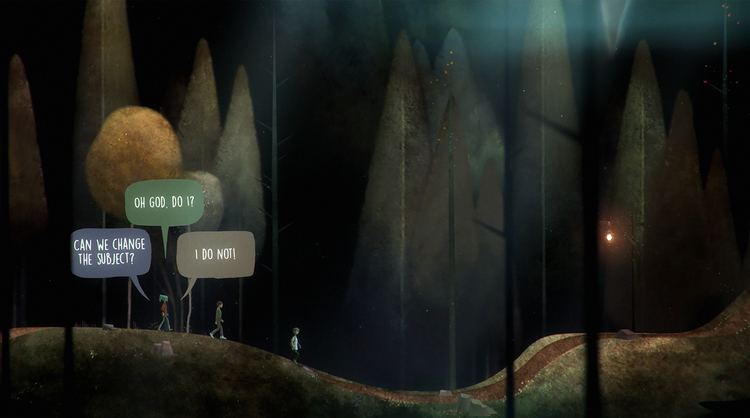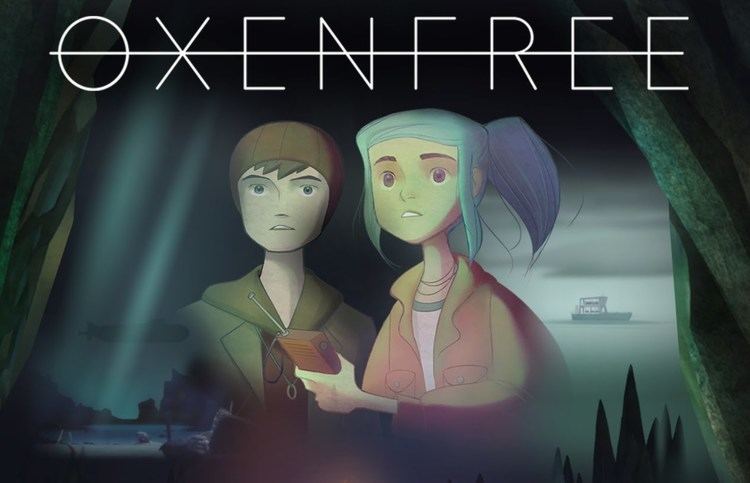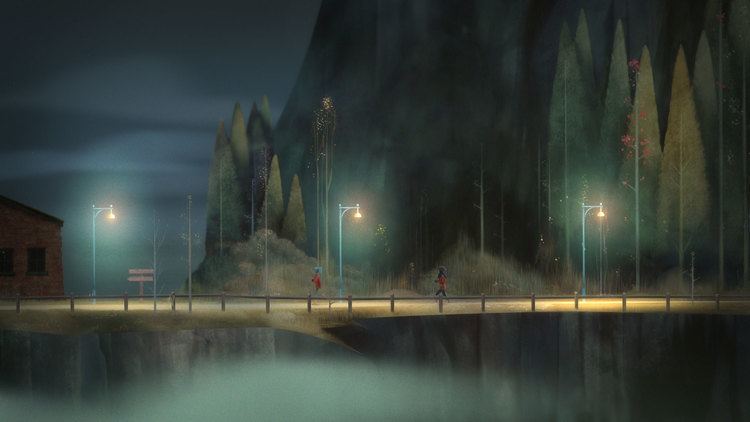8.4 /10 1 Votes8.4
79% Metacritic Director(s) Adam Hines Programmer(s) Bryant Cannon Writer(s) Adam Hines Genre Adventure game | 9/10 Steam Producer(s) Sean Krankel Artist(s) Heather Gross Initial release date 15 January 2016 | |||||||||||||||||||||||||||||||||
 | ||||||||||||||||||||||||||||||||||
Designers Kevin Riach, Spencer Stuard Similar Firewatch, ABZÛ, The Witness, Hyper Light Drifter, Obduction | ||||||||||||||||||||||||||||||||||
Oxenfree review
Oxenfree is a 2016 supernatural mystery graphic adventure video game developed and published by Night School Studio. The game was released for Microsoft Windows, OS X and Xbox One in January 2016, with PlayStation 4 and Linux versions released later that year.
Contents
- Oxenfree review
- Oxenfree launch trailer
- Gameplay
- Plot
- Epilogue and endings
- Development
- Audio
- Release
- Reception
- Film adaptation and web series
- References

Oxenfree launch trailer
Gameplay

Oxenfree is a graphic adventure played from a 2.5D perspective. The game is mostly played through the focus of Alex, the main protagonist, a teenager who is visiting an abandoned island for an overnight party.

Instead of dialogue occurring during cutscenes, speech bubbles appear over Alex's head, allowing the player to choose what she says next in the conversation while also interacting with the game's world. Puzzles in the game are solved by finding the correct frequency on Alex's handheld radio, which can do everything from unlock doors to communicate with ghosts.
Plot

Alex (Erin Yvette), a teenager, is on the last ferry heading to Edwards Island for a weekend party. She is accompanied by Ren (Aaron Kuban), her friend and frequent drug user, and Jonas (Gavin Hammon), her new stepbrother. Alex and company soon meet Clarissa (Avital Ash), Alex's late brother Michael's ex-girlfriend, and Nona (Brittani Johnson), Clarissa's best friend and Ren's love interest. After camping on the beach, Alex, Ren, and Jonas explore the nearby caves, where it is rumored certain radio frequencies cause supernatural events. In a small cavern, Alex tunes and unexpectedly forms a rift. A voice answers and the two experience visions and pass out. Jonas then wakes Alex in front of Harden Tower. They get a call from Ren, who passed out in the woods and Clarissa then calls from Fort Milner, the decommissioned military fort on the island. The calls are cut off and both walk into the forest.

They discover a small house, turning off the main switch to a lamp glowing red and briefly plays a ukulele tune that Jonas seems to recognize before the streetlights jolt. They then take a cable car to a campground, with Jonas passionately asks about Michael. They find the grounds abandoned and time supernaturally repeats twice. The radio then "talks" again, but time loops to Jonas gone, and a figure taking her reflection appears and communicates. Time corrects when Alex plays a magnetophone. They spot Nona, claiming she saw an alternate Jonas and Alex, redirecting her to Harden Tower to find Clarissa.
Alex and Jonas start to befriend another and they find Ren, but time loops again to exhibit him doing strange activity only to find him gone when fixed. They find him possessed, which creates another rift that knocks him out. Ren wakes up and goes to Harden Tower, and Jonas and Alex go to Fort Milner to rescue Clarissa. Alex then uses the radio on a light in which a voice states a game and a door unlocks. While inside, Jonas is trapped and Alex's reflection appears in a mirror, giving Alex advice. After this, they find the backdoor combination and leave. A ghost then questions them and possesses Jonas, revealing that the ghosts are in fact the passengers of a submarine ripped into an alternate dimension. Alex creates a third rift that wakes Jonas. Both find Clarissa, but time loops to her hanged and repeats to her falling to her death. It then corrects to her gone.
Nona, Alex, Jonas and Ren meet at Harden Tower, where Jonas blames Ren. The feud subsides and Alex brings one of the others to find a key in an office, where Jonas apologizes. They break in and find the key, and two radios capable of unlocking locks on the island as well as a letter from the island's former resident detailing the existence of 12 beacons hidden on the island. They then find Clarissa unconscious, where she remembers Milner. The group then meet up in the boardwalk, where Clarissa blames Alex for everything and Michael's death, but time loops Alex and her companion back to the office. On the way back, time loops to a year ago as Alex sees Michael and Clarissa and hangs out. She loops back unconscious.
The group then goes to an estate to steal a boat and go home. The radio unlocks the gate and they search the estate. Soon after, Alex finds the estate with the bodies of Nona, Clarissa, Jonas and Ren. A possessed Clarissa informs Alex that the test is a hide-and-seek game, in which she passes. Alex's reflection again appears in a mirror. The group then wakes to find Clarissa in a bomb shelter. They find a schematic that details how to fix the tear: Tranposing onto the other side and tuning within. Jonas and Alex get to the hill, but time loops to where Nona informs that Ren "died", and loops to reveal different causes of his "Death". A ghost then possesses Jonas and tells her that Clarissa can't be saved and bargains, but Alex declines. The loops continuously keep repeating until Alex comforts Nona grieving Ren's death, correcting the loop.
Alex and Jonas then trek to the lookout post as Nona and Ren stand by to unlock the bomb shelter. As they conference, Jonas fears the possibility of a reset and thanks Alex for the time they spent. After collecting a series of notes and letters, time loops Alex a year ago again in the middle of a conversation with Michael and then corrects at the end. Alex and Jonas then meet up with Nona and Ren at the bomb shelter, and Alex and Jonas go in. Finding a possessed tape player, the frequency sends Alex to the rift's side. Going to the rift's cave, she tunes a rift that sends her into a void.
Encountering the possessed Clarissa, she is warned that she will die if the rift is closed and time will loop infinitely, but Clarissa will be kept if she goes through the portal. Alex can then leave, erasing Clarissa from existence; close the portal herself, trapping her with the ghosts; or if she has found enough letters, Alex can appeal to the crew members directly, convincing them to let both Clarissa and herself go. Going through various loops, the reflection figure is revealed to be Alex herself. She then loops back to a conversation to Michael, who admits that he and Clarissa are planning to move. Time then corrects.
Alex then wakes up with Jonas, Nona, Clarissa and Ren on the ferry back home, with Jonas informing her that whatever she did fixed the rift and that everything is normal. Everyone then reveals that, for a limited period, they revisited past memories. They then swear to not tell anyone about their experiences and all decide to do leisure to forget. Nona takes a final group picture.
Epilogue and endings
In the epilogue, Alex reveals that she had told her mom that she was going to sleepover at a friend's house. The ending can change based upon actions made in the game, with the layout of the picture itself changing as a consequence.
Delivering a statement on her experience, Alex can ether go to college in or out of her hometown or take time off, depending on a choice the player makes during the epilogue. Thereafter, in a swift and mysterious turn of events, the screen flickers and Alex tells the player she is going to meet up with Clarissa, Ren and Nona to go to Edward's Island and she is picking up Jonas, who she never met, before the screen flickers to black, revealing that the infinite loop is in effect.
In the Game+ ending, Alex, Jonas and Ren are near a supermarket before they go to the ferry, when Ren tells her to tune in to a frequency, which plays a song from the soundtrack before they hear a message from a future Alex, before she entered the cave to close the rift. Depending on the message and how the player responds throughout the resulting conversation, they can end up not going to the island, preventing the loop.
Development
Cousins Sean Krankel and Adam Hines founded Night School Studio in 2014, having long wanted to collaborate on a video game together. Hines and Krankel were interested in creating a game that told its story in a unique way. Krankel and Hines looked at other story-focused games, and felt that they either were linear stories driven by set pieces, or branching, player choice-influenced stories told through cut scenes. "We thought, why not let you move freely while communicating, interacting, and exploring a branching narrative?" Krankel recalled. "The first thing we wanted to do is make a game where communication is really sort of a key mechanic, but that people have more freedom than they do with all the other narrative-focused games. At its core, we wanted to never have a cut scene in the game, where you could walk and move freely and communicate with your friends, and even communicate with other beings and other kind of strange things." Rather than developing the gameplay and attaching a story to it, Night School focused on developing gameplay that would support the story they wanted to tell.
Night School wanted the story to have scary and supernatural elements, without verging on horror. "We wanted to something a little bit more [...] Spielberg-ian, and sort of give it a sense of wonder and have it, for awhile, just be actually interacting with these supernatural creatures where it's almost a little bit fun, and hopefully, gives you butterflies in your stomach before it gets pretty crazy," Krankel said. The developers were influenced by coming-of-age stories.
The focus on allowing the player and non-player characters to have conversations with no gameplay breaks proved a technical challenge, as Night School had to design levels and AI around the unpredictable nature of the player's actions. After the founding of Night School Studio on October 1, 2014, the team set up a casting call on Backstage which expired on November 21, 2014. On March 1, 2015, an official teaser was posted by Night School. The game was then announced four days after, with the plot revolving around four teenagers exploring a strange island littered with ghosts. According to the Los Angeles Times, Night School Studio only had enough of an undefined budget to create Oxenfree.
Oxenfree was developed primarily using the Unity game engine, Adobe Photoshop, and Autodesk Maya.
The original artwork was created by Heather Gross, and the script was written by Adam Hines, lead writer from Tales from the Borderlands.
The first gameplay footage was released on May 18, 2015. It was announced on October 23, 2015 that the game would be released in January 2016, with the second teaser from the game posted onto the YouTube account. After its release for Microsoft Windows, the PlayStation 4 version of the game was announced on April 27. After release, Skybound Entertainment approached to help develop merchandise and the game for additional media.
Audio
The music was composed by American composer and sound designer Andrew Rohrmann, known under his alias scntfc, also designing the sound of the game as well. The soundtrack was released on January 15, 2016 to accompany the game, with a vinyl release on 25 May.
Release
The game itself also has an alternate reality counterpart. Within the game are radio frequencies that hint to a real phone number. This phone number led players to the Twitter account @xray9169363733. The account posted various cryptic, coded messages, all of which seemed to point to a real world location. On May 7, 2016, Youtuber Jesse Cox posted a video similar to the PS4 Oxenfree trailer, but with several letters highlighted in red. This led players to www.edwardsisland.com. Several messages were found, but most important was "MILNER IS WARD", confirming that a special object would be hidden at Fort Ward, WA. The object was revealed to be a box with letters by Alex from all the possible timelines from the game warning her not to go to Edwards island, and a manually operated tape player with two paper music tapes of songs from the game soundtrack.
Reception
Oxenfree received positive reviews from critics. Wired's Chris Kohler wrote that "Oxenfree shows some smart thinking about the relationship between games and players," and that as Night School's first game, it was an "auspicious debut." Destructoid's Nic Rowen praised the game for taking inspiration from old movies but still being "anything but generic"; "It dials into its own style and mood, tapping into something very heartfelt and special. It might just be the best 'horror' game I've played in years," he wrote. A less enthusiastic review was offered by Allegra Frank for Polygon, who wrote that despite offering many promising attributes, "I finished Oxenfree with my mouth agape, feeling wholly unsatisfied."
The game's audiovisual presentation was commonly considered a strength of the game. Rowen called the game's watercolor art style "gorgeous". Matt Buchholtz of Electronic Gaming Monthly favorably contrasted Oxenfree's traditional media style with the much more common retro pixel styling of indie games. Rowen, Buchholtz, and others also noted that the contrast between the watercolor look of the environment and the sharp, digital effects of the paranormal. "The studio’s choice to completely split the art styles between the normal world and the mystical is a massive success." said Buchholtz.
Frank credited Oxenfree with not relying on "lazy, clichéd 'young person' speech"; reviewers also felt that the naturalistic dialogue of Oxenfree was a strength, while IGN's Kallie Plagge felt that characters such as Ren had grating or stilted dialogue. GamesTM credited the game with delivering "remarkably organic" dialogue options that lacked any clear "good" or "bad" associations, and their effect on the character interactions and plot, though they felt the script failed to convey the distress of the characters in their exceptional circumstances. Plagge noted that despite her efforts, some dialogue choices unavoidably hurt relationships in the game. "It’s an important reminder that you can’t “win” social situations, and that kept Oxenfree’s supernatural plot points grounded in reality," she wrote. GameSpot's Corriea appreciated that some consequences of dialogue choices did not become clear until much later in the game, encouraging repeat playthroughs to try different approaches.
The nature of the dialogue system received a mixed reception.
GameSpot gave the game a score of 8/10, saying "It doesn't ask you any big questions, and certainly isn't easy in relenting its answers; Oxenfree just is what it is, a big little game about the all-too-human inability to let go of what hurts us." PC Gamer gave the game a score of 83, calling it "A beautiful story-driven adventure with a compelling story and great characters, set on an island filled with intriguing mysteries." However, they also said that it had "lack of challenging puzzles, and . . . the characters often seem a little too relaxed considering the terrifying things happening to them."
Film adaptation and web series
Writer Robert Kirkman is planning to help adapt Oxenfree into a film and a web-series via his company Skybound Entertainment. On January 11–14, 2016, Skybound released four episodes as part of their Creator Series about the creation of Oxenfree, detailing the story, art, mechanics, and voice acting.
